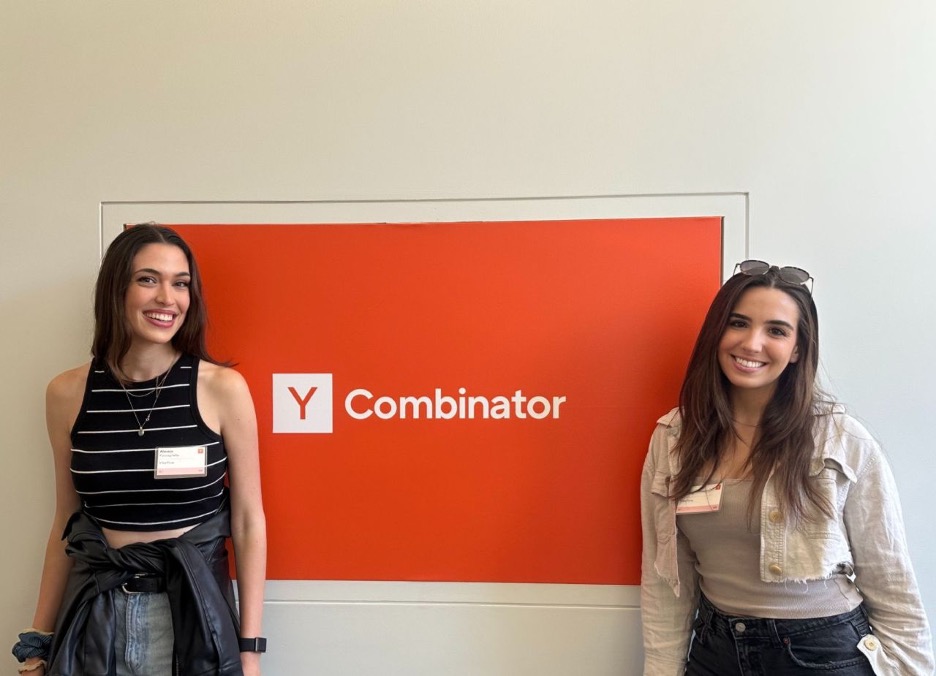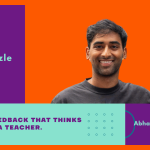Elia Saquand and Alessia Paccagnella started VibeFlow to solve one of the most frustrating problems in AI-era app development: prototypes that look great but can’t ship. Their platform makes backends visible, editable, and production-ready from day one.

Elia Saquand and Alessia Paccagnella, co-founders of VibeFlow, at Y Combinator headquarters in California.
1. What core problem convinced you to start VibeFlow, and why is it such a big deal for teams trying to ship real products beyond prototypes?
Elia Saquand: AI and no-code tools make it easy to spin up a beautiful demo, but impossible to go beyond it. The frontend looks great, until you try to add real data models, authentication, or APIs and the backend falls apart. Teams end up stitching together tools, guessing what the AI built, and re-prompting endlessly.
That’s where everything breaks down: sales teams and PMs can prototype fast, but they can’t ship or hand off to developers. The result is weeks of rework and lost momentum right when reliability matters most.
We started VibeFlow to fix that. By making the backend visible, editable, and debuggable, we turn disposable prototypes into production-ready systems. Teams can keep iterating, keep control, and keep shipping, instead of starting over.
2. Was there a specific moment or painful project that made you decide to fix black-box backends? What happened, and what did you learn?
Elia Saquand: We kept seeing the same pattern: teams stitching together Lovable for the frontend, n8n for the logic, and Supabase for the database, trying to build a full-stack app in no-code. They hoped it would behave like one system, but in reality, it was three black boxes duct-taped together. No one owned the code; everything lived behind someone else’s dashboard. Some teams even shipped customer-critical workflows over public webhooks, and debugging meant chasing silent failures across three dashboards. That’s when we learned: you can’t build reliable systems on rented logic.
3. You’ve both shipped visual or no-code systems and serious AI or ML work before. Which past lessons or failures most shaped the way VibeFlow works today?
Elia Saquand: We’d both built low-code systems before, and one thing kept repeating: they were too technical for non-technical users. In biotech, for instance, we saw powerful workflow tools go unused because most scientists weren’t comfortable with nodes, configs, or data types. At the same time, those same users would never trust a fully black-box AI, they need to see and control what’s happening. That’s what shaped VibeFlow: we use AI to translate natural language into low-code logic, so results are both deterministic and transparent. The AI helps users build, but the user still owns the logic.
4. In plain English, how does VibeFlow turn a prompt into a production-ready app where the backend is actually visible, debuggable, and maintainable?
Alessia Paccagnella: When you describe your app in natural language, VibeFlow turns that prompt into a clear visual map of how the app works, showing the data, the actions it performs, and how everything connects. You can click into any part, see what it does, and change it yourself or with AI help. The backend and frontend stay in sync and always visible, so if something doesn’t work, you can see exactly where and fix it. Instead of hiding the logic, VibeFlow makes it transparent so that you stay in control of what the AI builds.
5. What is unique about your Visual Backend Editor, especially in how it models data, APIs, workflows, and integrations so non-experts can still reason about the system?
Alessia Paccagnella: VibeFlow doesn’t fake the backend. It generates real, production-grade backend code, not a visual simulation locked inside our platform. The code is visible, editable, and exportable, so users really own what they build. Each block in the graph represents something real: a data model, an API call, or a workflow step, connected by visible inputs and outputs. Integrations like databases, authentication, or third-party services appear as ready-to-use blocks and can be tested directly inside the graph.
Unlike traditional low-code tools, VibeFlow was designed AI-first. Our AI agent understands the graph structure and can safely modify any part of it. Non-experts can use natural language to evolve their app while seeing exactly how it works. This shared model bridges visual simplicity and technical depth, making the backend both understandable and extensible.
6. How do you ensure code quality and safety, including type-safe APIs, authentication, secrets, data modeling, and AI agents, without overwhelming users?
Alessia Paccagnella: VibeFlow ensures code quality and safety by generating real, type-safe backend code behind the visual graph in a deterministic way. Every node in the graph corresponds to validated, production-ready logic from APIs and data models to authentication and secrets management. The graph itself is designed with guardrails: users can’t create insecure or inconsistent connections, and AI edits are constrained by the same rules as human ones. As experienced software engineers, we’ve embedded production best practices directly into the system, so non-experts get reliability and safety by design, without ever touching low-level code.
7. Where did you hit the toughest engineering walls, such as mapping natural language intents to executable graphs or balancing determinism and flexibility? What did you choose not to build?
Alessia Paccagnella: Our toughest engineering challenge was abstracting complex backend code into high-level nodes and flows that show users only what matters. The second was balancing determinism and flexibility. We chose deterministic graph compilation over dynamic runtime edits, so the AI can suggest and adjust logic safely but never touch live code. We deliberately avoided self-writing runtime systems in favor of predictable, inspectable outputs, giving users full control and traceability over how their apps evolve.
8. Can you share one or two concrete user stories where VibeFlow replaced a fragmented stack and unlocked real production velocity?
Elia Saquand: One customer was spending over $1,000 a month juggling Lovable, n8n, Supabase, and Claude Code just to build and iterate on prototypes. It took him over two weeks to build a first prototype, which couldn’t be reused because no one owned the code, so developers had to rebuild everything from scratch once clients approved it. With VibeFlow, he now builds the same prototype in a single day using one platform, no manual connections, no vendor juggling. He can iterate directly with clients, and when it’s ready, developers can take over seamlessly within the same environment. What used to be a disposable prototype is now a real, production-ready foundation.
9. What is the most common pushback you hear, whether security, reliability, or skepticism that AI can replace engineers, and how do you address it?
Alessia Paccagnella: The main concern we hear is trust: people worry that AI-generated backends are unreliable or opaque, and that engineers will lose control. We address that head-on by making VibeFlow completely transparent: every AI action maps to a visible, deterministic graph that compiles to real, type-safe code. Nothing runs that you can’t see, inspect, or edit. Engineers stay in control while AI accelerates the work. We’re not replacing developers, we’re removing the boilerplate and wiring, so they can focus on what actually matters. Once people see that the AI isn’t a black box but a copilot operating on real code, the skepticism fades.
10. How are you thinking about developer experience and community, with templates, patterns, and guardrails, so teams can evolve apps without re-prompting or rewriting from scratch?
Alessia Paccagnella: VibeFlow is designed for reuse and collaboration. Every backend or workflow built in VibeFlow, manually or with AI, can be saved as a reusable, composable template. Over time, each team builds a shared library of nodes and patterns they can remix or combine to evolve their apps faster and move smarter with every project. For more advanced use cases, developers can create custom “code-to-node” components that extend the team library, giving non-technical teammates safe building blocks to expand existing apps. On the frontend side, you can generate a project from any live website using its URL, or bring in an existing frontend built in VibeFlow or another platform.
11. Long-term vision: do you see VibeFlow making anyone a full-stack builder, or is the deeper mission to redefine how SaaS itself is produced and operated?
Elia Saquand: We believe VibeFlow will make far more people “full-stack capable,” but our deeper mission is to redefine how SaaS is produced and operated. Just as Shopify turned anyone into an e-commerce founder, VibeFlow will turn anyone into a SaaS creator. We’re replacing black-box backends and scattered services with transparent, versioned graphs that anyone can understand and evolve. AI becomes a true copilot, not a code generator, translating intent into logic that’s inspectable, editable, and reliable. Over time, VibeFlow will power a marketplace of reusable backend components, where teams and individuals can build, share, and extend each other’s systems. Our vision is to make VibeFlow the platform where modern businesses are built, run, and evolved: the Shopify for SaaS.
12. What is your operating cadence as co-founders, moving from Zurich to San Francisco and through YC sprints? Any advice for founders building AI-native dev tools right now?
Elia Saquand: YC runs on two-week sprints; we kept the spirit but made it faster. Since the batch, we’ve switched to Weekly Goals: one-week sprints with visible, measurable outcomes. Every week has a heartbeat: Monday kick-off, Wednesday check-in, Friday alignment. Each person owns 3–5 goals that are explicit, output-oriented, and achievable. It’s short enough to stay focused, long enough to ship something real. That rhythm keeps us in motion, grounded in results, and always pushing something live.
The same principle applies to building AI-native dev tools: ship, learn, refine. Don’t make AI the product: make it part of your product. Use it where it creates leverage, but wrap it in great UX, clear workflows, and domain insight. Sometimes the smartest move is not to use AI at all. Build with the future in mind: models will keep improving, so design your system so that better AI unlocks more value instead of breaking your foundation.
Editor’s Note
VibeFlow gives builders real control over AI-generated apps. It turns prompts into transparent backend logic, combines low-code and natural language, and keeps humans in charge. This interview reveals how their team is rethinking what it means to ship software in the age of AI.



